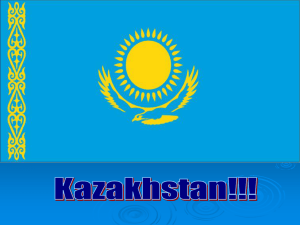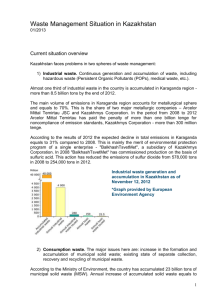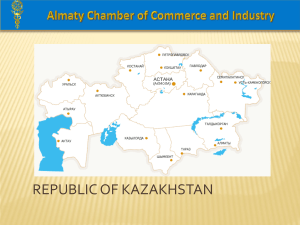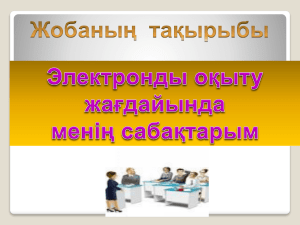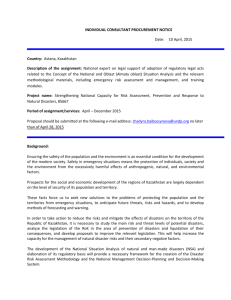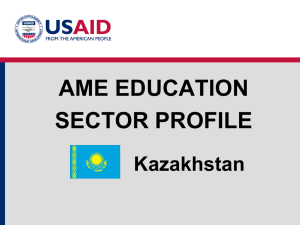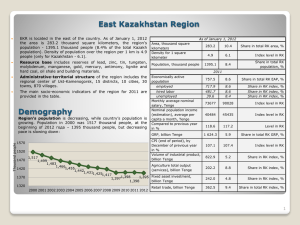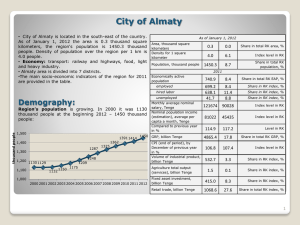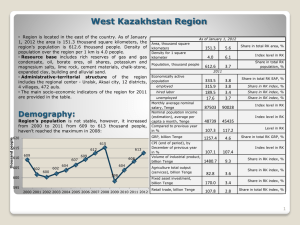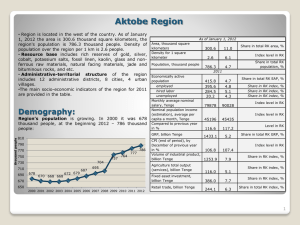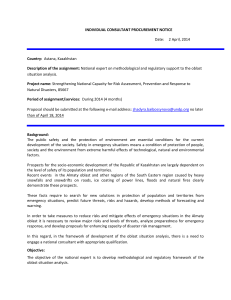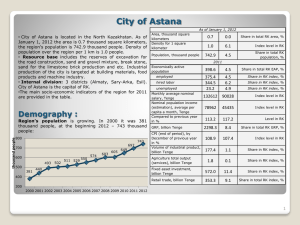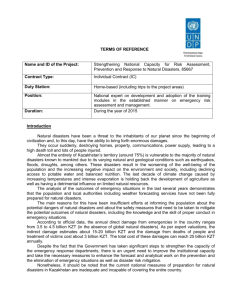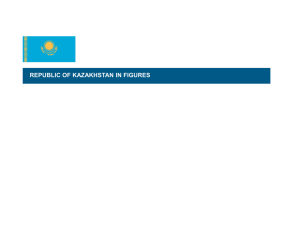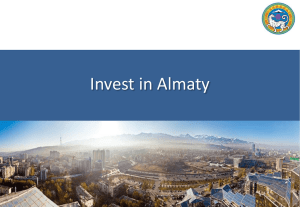Financing of Higher Education in Kazakhstan
advertisement
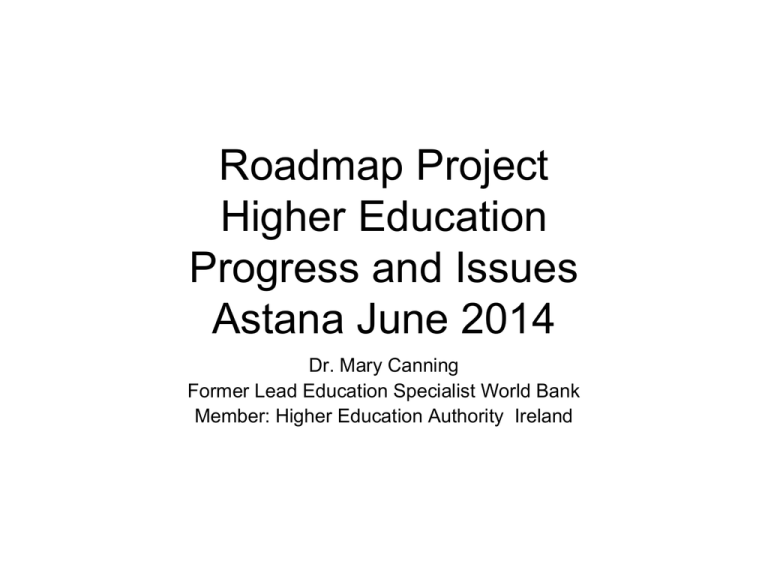
Roadmap Project
Higher Education
Progress and Issues
Astana June 2014
Dr. Mary Canning
Former Lead Education Specialist World Bank
Member: Higher Education Authority Ireland
Some Statistics: 2014
• Declining Numbers of Institutions: 149
HEIs in 2011 reduced 130 in 2014;
• Estimated total enrolment in higher
education is 24.4% of the 18-24 year olds;
• Improvement in drop out rates and a
steady increase in the numbers of PhD
students enrolled;
• But absolute enrolments are declining…..
Absolute Numbers of Enrolments are declining
Student Numbers, 2009-14
Students ('000)
640
620
600
580
560
540
520
500
480
460
2009-2010
2010-2011
2011-2012
2012-1013
2013-2014
Quality
• By May 2014, out of a total of 130
institutions, 43% had completed the
accreditation process, of which 14% were
private institutions;
• However, there remains a reliance on
centralized quality control and on
compliance rather than a culture of quality
assurance and self-evaluation at the
institutional level.
Access and Equity
• The policy of reducing the number of HEIs
appears to have had a disproportionate
impact on oblasts with a greater incidence
of poverty.
Enrolment and Oblast Per Capita
Income
Tertiary enrolment related to oblast income per head, by oblast, 2012
6000
Atyrau
per capita regional product ('000 tenge)
5000
4000
Almaty city
Astana city
Mangistau
3000
West-Kazakhstan
2000
Pavlodar Aktobe
Karaganda
Kyzylorda
Nord-Kazakhstan
1000
Almaty oblast
East-KazakhstanKostanai
Akmola
Zhambyl
South-Kazakhstan
0
0
10
20
30
40
enrolment as % population 18-24
50
60
70
Access and Equity
• There are differences in enrolment levels
between rural and urban areas which may
be attributed to the difficulties that school
leavers in rural areas, especially those
from small schools, have in achieving the
grades in the Unified National Test
required for access to full time higher
education.
Changes in Enrolment related to
Income
Oblast poverty and percentage change in tertiary enrolment , 2003-4 to 2009-10
60
%
e
n
r
o
l
m
e
n
t
c
h
a
n
g
e
Pavlodar
40
Astana city
20
Almaty city
0
East-Kazakhstan
West-Kazakhstan
Zhambyl
Aktobe
Karaganda
Kostanai
Akmola
-20
Almaty oblast
South-Kazakhstan
Kyzylorda
Atyrau
-40
Mangistau
Nord-Kazakhstan
-60
-80
0
5
10
15
percentage classified as poor 2009
20
25
Relevance to Labour Market
• The diagnostic Report concluded that there is a
national need to :
– Increase the absolute numbers of students in higher
education as well as the proportion of graduates in
Science and Technology;
– Focus on strong technician-level tertiary education
systems at the level of ISCED 5B (Tertiary B);
– Strengthen information about career opportunities
and the labour market;
– Provide defined pathways through the education
system to encourage lifelong learning.
Governance
1. Autonomy/Academic Freedom: Public HEIs are by legislation tied to
Central Government and have little control over own budgets;
2. Accountability: little public trust/corruption is a major concern;
3. Major Challenge is to achieve better governance and trust and to
attract financing from industry for applied research;
• Regulatory Constraints;
• Revision of Law on State Property;
• Not for profit issue;
• Non fungible budgets based on historical norms and tied to rigid
categories;
• Restricted Institutional influence on curriculum content and
academic programme development.
Institutional Accountablity
Priorities:
1. New model of Corporate Governance;
2. New Model of Institutional Leadership;
3. Culture of Quality Assurance and selfevaluation needed at institutional level;
4. Institutional Capacity Building
Research
Funding
• In 2013, Kazakhstan spent 48,968 million tenge (0.16%
of GDP) for Research. Of this, 7,874 million tenge (
16%) was for capital investment;
• 70% of these funds were allocated to Higher Education
Institutions; the remaining 30% were allocated to
Research Institutions;
The following table shows that this spend is proportionately
small when compared with Korea or the USA.
Selected Country Comparators for Research Funding
Source: OECD Main Science and Technology Indicators. 2012. Kazakhstan 2013 expenditure
Public Expenditures on R&D (GERD), 2010 as % GDP
Korea
United States
Russian Federation
Mexico
Kazakhstan
0
0.2
0.4
0.6
0.8
1
1.2
Research & Innovation
Progress to Date
• Capacity is being built for research and
innovation in HEIs, through the planned
establishment of one/ or two research and ten
innovation universities and through developing a
system for training qualified staff.
• Increase in post-graduate enrolments: in 2009,
there were 666 Ph.D. students enrolled in
Kazakh universities; by 2013 that number had
risen to 1533.
Research
& Innovation
Issues
• Further measures are needed to:
– Improve coordination among the government
agencies responsible for funding research and
innovation and integrate the activities of the Research
Agencies and HEIs;
– Reform allocation mechanisms to improve efficiency;
– Encourage more basic research;
– Create a commercialization infrastructure for
researchers (institutions, training innovation
managers);
– Adjust the balance of postgraduate enrollments to
include more agricultural science and veterinary
medicine students.
Financing Higher Education
Mobilisation of Resources
• In 2013, Kazakhstan spent 0.44% of GDP on
higher education. Total expenditure for all levels
of higher education was 174,183 million tenge.
Of this 36, 697 million tenge (21%) was available
for capital investment;
• This spend is relatively little as measured either
as a percentage of GDP or on the basis of
expenditures per student as set out in the
following two comparative tables.
Annual expenditure per student by educational institutions for all
services, relative to GDP per capita (2010)
United States
OECD average
EU21 average
Korea
Russian Federation
Mexico
Kazakhstan
0
10
20
30
40
50
60
Countries are in descending order of GDP per capita (on PPP basis)
Source: OECD: Education at a Glance 2013, Table B1.4
Public Expenditure per Student
Mobilisation of Resources
2
R =income,
0.8469
Comparative public expenditure per tertiary student , 2009, by per capita
selected countries
50
public expenditure per tertiary student, 2009 ($'000)
45
Norway
40
35
Denmark
Switzerland
30
25
20
Sweden
France
15
10
Spain
NZ
Portugal
Slovenia Israel
Czech
Malaysia Hungary
Estonia
Mexico
Brazil
Slovakia
Bulgaria
Latvia Korea
Thai
KAZ Chile
Malta
5
0
0
10
20
30
Italy
UK
Aus
40
Netherlands
Austria
Ireland
Finland
Belgium
USA
50
GDP per capita 2009 ($'000)
60
70
80
90
Private Contributions
Mobilisation of Resources
• Kazakhstan relies heavily on private sources of
funding to support its higher education
institutions: in 2013, 73% of students used their
own or family resources to pay tuition fees;
• The next table shows that, internationally, this
low State contribution places Kazakhstan
considerably behind the EU Average, the OECD
Average and even the US average but close to
South Korea.
Public expenditure as % total tertiary expenditure, 2010
United States
OECD average
EU21 average
Korea
Russian Federation
Mexico
0.0
•
20.0
40.0
60.0
80.0
100.0
Countries are in descending order of GDP per capita (on PPP basis)
•
Source: OECD: Education at a Glance 2013, Table B2.3
Resource Mobilisation:Summary
•
The Roadmap Project Diagnostic Report concluded that Kazakhstan does
not have enough graduates and is not producing enough research to meet
either social or economic needs;
•
There is little evidence of philanthropic donations to HEIs.
•
Indicators such as salary levels for faculty that are so low as to invite
corruption and consistent feedback from employers that students are
coming out of college ill-prepared for the world of work suggest that the
level of funding is insufficient to meet Government goals for the sector;
•
Coupled to low Salaries there are very limited resources to improve
teaching and learning, to develop staff, to improve infrastructure, to
undertake basic research;
•
Kazakhstan needs to increase the level of investment in higher education.
Financing Higher Education
Allocation of Resources
• State Grants: merit based, voucher-like;
• Recipients: 27% in receipt of grants in
2013; small proportion allocated to some
disadvantaged groups such as orphans,
the disabled and students from rural
areas.
Financing Higher Education
Allocation of Resources
• Affordability: Kazakhstan has taken modest
steps to address the affordability of higher
education for the majority of students who do not
receive state grants.
– (i) the National Education Storage System (NESS).
– (ii) a student loan programme.
• However, although these programmes help
families pay for higher education, they do
nothing to reduce the overall cost of attendance
and do not materially improve affordability.
Financing Higher Education
Allocation of Resources
•
The allocation of State Grants discriminates against students from
rural areas and lower income students;
•
The large majority of students (73%) must use their own resources to
pay for higher education, making the issue of college affordability a
major policy consideration for the country;
•
University Fees may not be less than the State Grant: If the grant is
raised, fees will also be raised and thus, perversely, poorer students
will be excluded just at the time when the country needs to expand its
system;
•
The amount of the grant is currently relatively low, (approximately
600,000-700 000 tenge per student in public HEIs;) and the number of
grants is relatively small compared to the number of graduates needed
by the economy.
Policy Challenges
With scarce public resources devoted to higher education,
priorities are to:
• Rationalise the existing provision of higher education in
Kazakhstan;
• Develop New Governance Arrangements;
• Reorganise existing regressive education financing
allocation mechanisms;
• Increase the numbers of graduates from all geographic
locations;
• Increase the proportion of graduate in Science and
Technology;
• Support the development of a globally competitive
research base in HEIs.
Current Reform Initiatives (1)
• Number of institutions is being systematically reduced to
improve quality and efficiency and ensure diversity;
• As a means of quality assurance, in future, public
funding will be tied to accreditation.
• Public Funding will be tied to those HEIs that receive
accreditation. ( currently 43% of HEIs are accredited);
• Legal Reform to improve autonomy and develop
corporate management system in HEIs.
– Piloting New Governing Boards;
– Training HEI management teams;
– Development of system wide management data base.
Current Reform Initiatives (2)
• Improving access and admission systems;
• Review of current grant allocation
mechanism to improve the funding system
and ensure the effective functioning of
universities. (Pedagogical Universities
require special treatment to ensure their
sustainability);
Current Reform Initiatives (3)
• Diversification of Funding at HEI level:
Encourage development of multi-channel
financing of HEIs through new financial
management systems including the
development of endowment funds;
• Desired National Outcome: create an
awareness among policy makers of the need for
a greater share of public expenditure on Higher
Education in Kazakhstan.


